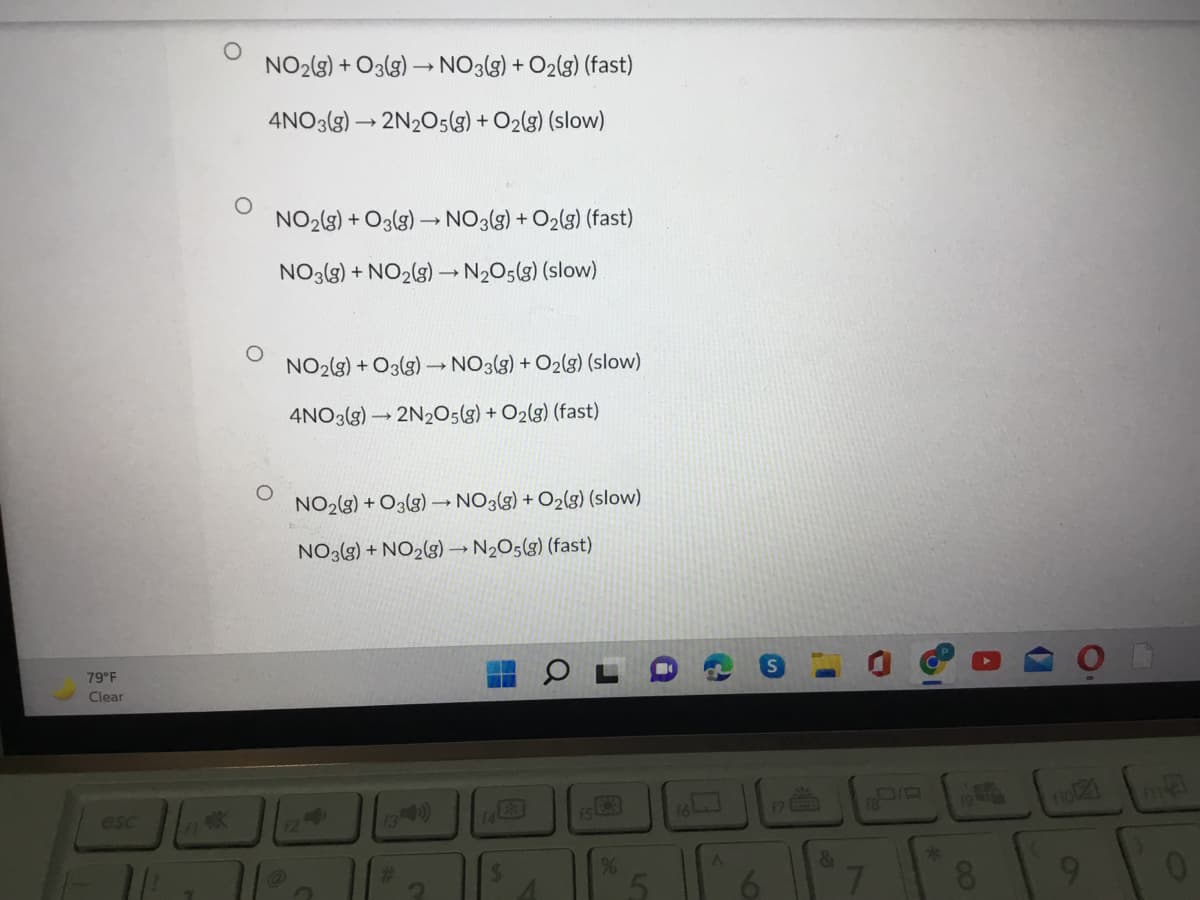eg) – 2N2O5(g) + O2(g) (slow) g) + O3(g) → NO3(g) + O2(g) (fast) (g) + NO2(g) N2O5(g) (slow) z(g) + O3(g) → NO3(g) + O2(g) (slow) D3l8) 2N205(g) + O2(g) (fast) P2(g) + O3lg) → NO3(g) + O2(g) (slow) D3(g) + NO2(g) –→ N2O5(g) (fast)
eg) – 2N2O5(g) + O2(g) (slow) g) + O3(g) → NO3(g) + O2(g) (fast) (g) + NO2(g) N2O5(g) (slow) z(g) + O3(g) → NO3(g) + O2(g) (slow) D3l8) 2N205(g) + O2(g) (fast) P2(g) + O3lg) → NO3(g) + O2(g) (slow) D3(g) + NO2(g) –→ N2O5(g) (fast)
Chemistry: The Molecular Science
5th Edition
ISBN:9781285199047
Author:John W. Moore, Conrad L. Stanitski
Publisher:John W. Moore, Conrad L. Stanitski
Chapter11: Chemical Kinetics: Rates Of Reactions
Section11.7: Reaction Mechanisms
Problem 11.12E
Related questions
Question
22

Transcribed Image Text:NO2(3) + O3(g) → NO3(g) + O2(g) (fast)
4NO3(g) – 2N205(g) + O2(g) (slow)
NO2(3) + O3(g) → NO3(g) + O2(g) (fast)
NO3(g) + NO2(g) N205(g) (slow)
NO2(g) + O3(g) NO3(g) + O2(g) (slow)
4NO3(g) → 2N205(g) + O2(g) (fast)
NO2(g) + O3(g)→ NO3(g) + O2(g) (slow)
NO3(g) + NO2(g)→N2O5(g) (fast)
79°F
Clear
esc
13)
17
fol21
%23
&
5.
8.
![One of the reactions that occurs in polluted air in urban areas is 2NO2(g) +O3(g) → N2O5(g) + O2(g). Assume that a species with the
formula NO3 is involved in the mechanism, and the observed rate law for the overall reaction is rate = k[NO2][O3].
Propose a mechanism for this reaction that includes the species NO3 and is consistent with the observed rate law.
NO2(s) + O3(g) – NO3(g) + O2(g) (fast)
4NO3(g) → 2N2O5(g) + O2(g) (slow)
NO2(g) + O3(g) NO3(g) + O2(g) (fast)
NO3(g) + NO2(3) → N2O5(g) (slow)
NO2(8) + O3(g) – NO3(g) + O2(g) (slow)
4NO3(g) → 2N2O5(g) + O2(g) (fast)
NO2(3) + O3(g) – NO3(g) + O2(g) (slow)
7.
19-A
12
17
fno
12A
pri sc
delete
fA /S
19
ED $T
LLL
%23
4.
7.
8.
11](/v2/_next/image?url=https%3A%2F%2Fcontent.bartleby.com%2Fqna-images%2Fquestion%2Feee56e46-3b51-4285-99fa-b9f56906f093%2F0ea92815-b1d5-4bec-b789-c257411bc639%2Fl9gzxwg_processed.jpeg&w=3840&q=75)
Transcribed Image Text:One of the reactions that occurs in polluted air in urban areas is 2NO2(g) +O3(g) → N2O5(g) + O2(g). Assume that a species with the
formula NO3 is involved in the mechanism, and the observed rate law for the overall reaction is rate = k[NO2][O3].
Propose a mechanism for this reaction that includes the species NO3 and is consistent with the observed rate law.
NO2(s) + O3(g) – NO3(g) + O2(g) (fast)
4NO3(g) → 2N2O5(g) + O2(g) (slow)
NO2(g) + O3(g) NO3(g) + O2(g) (fast)
NO3(g) + NO2(3) → N2O5(g) (slow)
NO2(8) + O3(g) – NO3(g) + O2(g) (slow)
4NO3(g) → 2N2O5(g) + O2(g) (fast)
NO2(3) + O3(g) – NO3(g) + O2(g) (slow)
7.
19-A
12
17
fno
12A
pri sc
delete
fA /S
19
ED $T
LLL
%23
4.
7.
8.
11
Expert Solution
This question has been solved!
Explore an expertly crafted, step-by-step solution for a thorough understanding of key concepts.
Step by step
Solved in 2 steps

Knowledge Booster
Learn more about
Need a deep-dive on the concept behind this application? Look no further. Learn more about this topic, chemistry and related others by exploring similar questions and additional content below.Recommended textbooks for you

Chemistry: The Molecular Science
Chemistry
ISBN:
9781285199047
Author:
John W. Moore, Conrad L. Stanitski
Publisher:
Cengage Learning

Chemistry & Chemical Reactivity
Chemistry
ISBN:
9781337399074
Author:
John C. Kotz, Paul M. Treichel, John Townsend, David Treichel
Publisher:
Cengage Learning


Chemistry: The Molecular Science
Chemistry
ISBN:
9781285199047
Author:
John W. Moore, Conrad L. Stanitski
Publisher:
Cengage Learning

Chemistry & Chemical Reactivity
Chemistry
ISBN:
9781337399074
Author:
John C. Kotz, Paul M. Treichel, John Townsend, David Treichel
Publisher:
Cengage Learning


Chemistry: An Atoms First Approach
Chemistry
ISBN:
9781305079243
Author:
Steven S. Zumdahl, Susan A. Zumdahl
Publisher:
Cengage Learning

Chemistry
Chemistry
ISBN:
9781305957404
Author:
Steven S. Zumdahl, Susan A. Zumdahl, Donald J. DeCoste
Publisher:
Cengage Learning

Chemistry: Principles and Practice
Chemistry
ISBN:
9780534420123
Author:
Daniel L. Reger, Scott R. Goode, David W. Ball, Edward Mercer
Publisher:
Cengage Learning